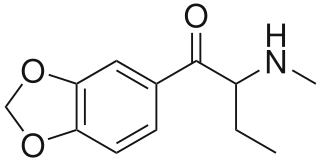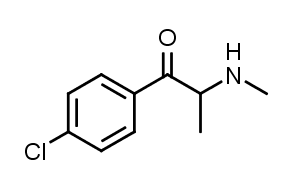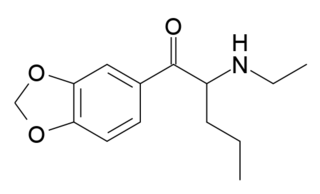
D-norpseudoephedrine, also known as cathine and (+)-norpseudoephedrine, is a psychoactive drug of the phenethylamine and amphetamine chemical classes which acts as a stimulant. Along with cathinone, it is found naturally in Catha edulis (khat), and contributes to its overall effects. It has approximately 7-10% the potency of amphetamine.

Butylone, also known as β-keto-N-methylbenzodioxolylbutanamine (βk-MBDB), is an entactogen, psychedelic, and stimulant psychoactive drug of the phenethylamine chemical class. It is the β-keto analogue of MBDB and the substituted methylenedioxyphenethylamine analogue of buphedrone.

Methylone is an empathogen and stimulant psychoactive drug. It is a member of the substituted amphetamine, substituted cathinone and substituted methylenedioxyphenethylamine classes.

Ethylone, also known as 3,4-methylenedioxy-N-ethylcathinone, is a recreational designer drug classified as an entactogen, stimulant, and psychedelic of the phenethylamine, amphetamine, and cathinone chemical classes. It is the β-keto analogue of MDEA ("Eve"). Ethylone has only a short history of human use and is reported to be less potent than its relative methylone. In the United States, it began to be found in cathinone products in late 2011.

Methylenedioxypyrovalerone (MDPV) is a stimulant of the cathinone class that acts as a norepinephrine–dopamine reuptake inhibitor (NDRI). It was first developed in the 1960s by a team at Boehringer Ingelheim. Its activity at the dopamine transporter is six times stronger than at the norepinephrine transporter and it is virtually inactive at the serotonin transporter. MDPV remained an obscure stimulant until around 2004 when it was reportedly sold as a designer drug. Until it was banned in 2011, products containing MDPV and labeled as bath salts were sold as recreational drugs in gas stations and convenience stores in the United States, similar to the marketing for Spice and K2 as incense.

α-Pyrrolidinopropiophenone (α-PPP), is a stimulant drug. It is similar in structure to the appetite suppressant diethylpropion and has analogous effects in animals. Little is known about this compound, but it has been detected by laboratories in Germany as an ingredient in "ecstasy" tablets seized by law enforcement authorities. This drug has been found to produce stimulant effects in animals and presumably also produces these effects in humans, based on the context in which it has been found.

Ethcathinone, also known as ethylpropion or ETH-CAT, is a stimulant drug of the phenethylamine, amphetamine, and cathinone chemical classes. It is an active metabolite of the prodrug diethylcathinone and is fully responsible for its effects. Ethcathinone has been identified as an ingredient in both quasi-legal "party pills", and, along with mephedrone, has also been reported as having been sold as "ecstasy" in the Australian city of Cairns.

4-Bromomethcathinone is a psychoactive drug and research chemical of the phenethylamine, amphetamine, and cathinone chemical classes. It acts as a serotonin and norepinephrine reuptake inhibitor, but acts more like an antidepressant than a stimulant. It is currently unclear whether the 4-halogenated cathinones share the selective serotonergic neurotoxicity of their corresponding amphetamines.

Flephedrone, also known as 4-fluoromethcathinone (4-FMC), is a stimulant drug of the cathinone chemical class that has been sold online as a designer drug starting in 2008.

α-Pyrrolidinopentiophenone is a synthetic stimulant of the cathinone class developed in the 1960s that has been sold as a designer drug. Colloquially, it is sometimes called flakka. α-PVP is chemically related to pyrovalerone and is the ketone analog of prolintane.

Naphyrone, also known as O-2482 and naphthylpyrovalerone, is a substituted cathinone drug derived from pyrovalerone that acts as a triple reuptake inhibitor, producing stimulant effects and has been reported as a novel designer drug. No safety or toxicity data is available on the drug.

α-Pyrrolidinobutiophenone (α-PBP) is a stimulant compound developed in the 1960s which has been reported as a novel designer drug. It can be thought of as the homologue lying between the two better known drugs α-PPP and α-PVP.

3-Fluoromethcathinone is a chemical compound of the phenethylamine, amphetamine, and cathinone classes that has been sold online as a designer drug. It is a structural isomer of flephedrone (4-fluoromethcathinone).

α-Pyrrolidinohexiophenone is a synthetic stimulant drug of the cathinone class developed in the 1960s which has been reported as a novel designer drug.

4'-Methoxy-α-pyrrolidinopentiophenone is a stimulant drug of the cathinone class that has been sold online as a designer drug.

iS IT M E T H THO 4-Chloromethcathinone is a stimulant drug of the cathinone class that has been sold online as a designer drug.

N-Ethylhexedrone (also known as α-ethylaminocaprophenone, N-ethylnorhexedrone, hexen, and NEH) is a stimulant of the cathinone class that acts as a norepinephrine–dopamine reuptake inhibitor (NDRI) with IC50 values of 0.0978 and 0.0467 μM, respectively. N-Ethylhexedrone was first mentioned in a series of patents by Boehringer Ingelheim in the 1960s which led to the development of the better-known drug methylenedioxypyrovalerone (MDPV). Since the mid-2010s, N-ethylhexedrone has been sold online as a designer drug. In 2018, N-ethylhexedrone was the second most common drug of the cathinone class to be identified in Drug Enforcement Administration seizures.

N-Ethylpentylone is a substituted cathinone and stimulant drug which was developed in the 1960s.

α-Pyrrolidinoheptaphenone is a designer drug of the pyrrolidinophenone class of cathinones. It is the higher homolog of α-pyrrolidinohexiophenone (α-PHP).

4-Methyl-α-ethylaminopentiophenone (4-MEAP) is a designer drug of the cathinone class. It is a higher homolog of 4-methylpentedrone (4-MPD) with an ethyl group in place of the methyl group. 4-MEAP has been found in samples of drugs sold as 4-MPD.




















